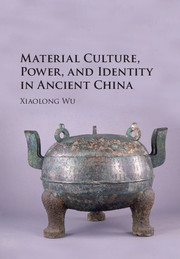Book contents
- Frontmatter
- Dedication
- Contents
- List of Figures
- List of Maps
- List of Tables
- Acknowledgments
- INTRODUCTION
- 1 HISTORICAL SETTING AND APPROACHES TO THE STUDY OF AN ANCIENT STATE IN WARRING STATES CHINA
- 2 LIFE, DEATH, AND IDENTITY IN ZHONGSHAN: SORTING OUT THE ARCHAEOLOGICAL EVIDENCE
- 3 ROYAL MORTUARY PRACTICE AND ARTIFACTS: HYBRIDITY, IDENTITY, AND POWER
- 4 INTERSTATE POLITICS AND ARTISTIC INNOVATION DURING THE REIGN OF KING CUO
- 5 STATECRAFT AND ZHONGSHAN BRONZE INSCRIPTIONS
- 6 FUNERARY ARCHITECTURE, KINGLY POWER, AND COURT POLITICS
- CONCLUSION
- Appendices
- Notes
- Bibliography
- Index
2 - LIFE, DEATH, AND IDENTITY IN ZHONGSHAN: SORTING OUT THE ARCHAEOLOGICAL EVIDENCE
Published online by Cambridge University Press: 23 March 2017
- Frontmatter
- Dedication
- Contents
- List of Figures
- List of Maps
- List of Tables
- Acknowledgments
- INTRODUCTION
- 1 HISTORICAL SETTING AND APPROACHES TO THE STUDY OF AN ANCIENT STATE IN WARRING STATES CHINA
- 2 LIFE, DEATH, AND IDENTITY IN ZHONGSHAN: SORTING OUT THE ARCHAEOLOGICAL EVIDENCE
- 3 ROYAL MORTUARY PRACTICE AND ARTIFACTS: HYBRIDITY, IDENTITY, AND POWER
- 4 INTERSTATE POLITICS AND ARTISTIC INNOVATION DURING THE REIGN OF KING CUO
- 5 STATECRAFT AND ZHONGSHAN BRONZE INSCRIPTIONS
- 6 FUNERARY ARCHITECTURE, KINGLY POWER, AND COURT POLITICS
- CONCLUSION
- Appendices
- Notes
- Bibliography
- Index
Summary
THE MANY STRUCTURES AND ARTIFACTS RECENTLY EXCAVATED from the Zhongshan capital, Lingshou, provide a broader archaeological context in which the remains from King Cuo's tomb can be examined and interpreted. In addition, the cemeteries in and around Lingshou, and tombs in the Zhongshan territory beyond the capital, betray cultural changes and interactions in this area through the Eastern Zhou period. These archaeological contexts will be examined against the cultural and political background provided by relevant historical sources. The purpose of the following discussion is not to use one type of source to complement another, although sometimes archaeological evidence and historical evidence do seem to illuminate each other. On more occasions, interpretations derived from historical and archaeological records contradict, instead of confirm, each other. Instead of treating historical texts as authoritative and archaeological remains as supplementary, or vice versa, I will interpret them on their own merit and see what different pictures each of the two categories of sources helps to construct. By accepting that both textual documents and archaeological data are ambiguous, context-dependent, and open to interpretation, and that they do not have to match, we can “take advantage of different aspects of both textual and non-textual data,” and as a result, we will be able to get a more multifaceted understanding of past societies in this area. The sociopolitical context reconstructed through archaeological and textual sources in this chapter will also shed light on the relation between artifacts and politics discussed in the following chapters.
SHANG AND WESTERN ZHOU PERIOD REMAINS IN THE REGION
Sites of the Shang and Western Zhou periods abound in the area east of the Taihang mountains, which later became Xianyu and Zhongshan territory. Shang sites were found in Gaocheng 藁城, Shijiazhuang 石家莊, Zhengding 正定, Wuji 無極, Lingshou, Pingshan, Quyang 曲陽, Wanxian 完縣, and Mancheng 滿城 counties, and yielded assemblages of Shang-style bronze vessels and weapons, some inscribed with prominent Shang clan names. Shang (or Yin) people must have settled in this area from the Middle Shang period. Western Zhou period sites were found in Gaocheng, Wuji, Quyang, Tangxian 唐縣, and Mancheng along the eastern foot of the Taihang mountains. Typical Western Zhou-style bronzes from these sites include ding 鼎, li 鬲, gui 簋, hu 壺, pan 盤, and yi 匜. No northern-style items of this period have been found in this region.
- Type
- Chapter
- Information
- Material Culture, Power, and Identity in Ancient China , pp. 26 - 76Publisher: Cambridge University PressPrint publication year: 2017



